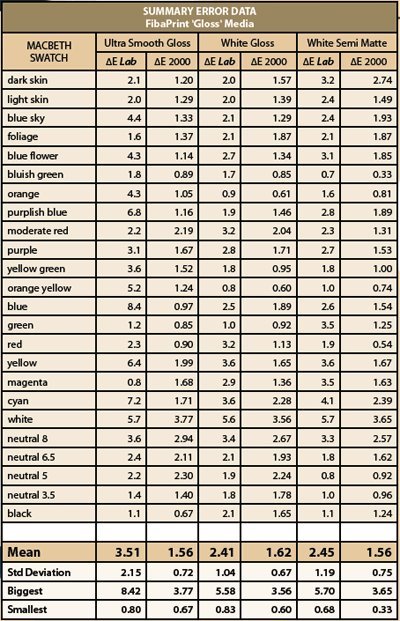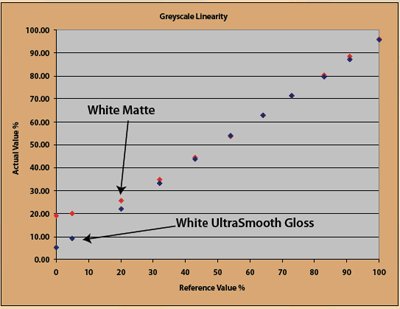articles/Paper/innovafineart-page4
Paper Chase - Innova Digital Fine Art Paper - part 4 of 1 2 3 4 5
by Mike McNamee Published 01/02/2008

The only niggle was with the White Semi Matte. This had been cut across the grain - that is, the residual roller marks ran across the short direction of the A3 sheet. This induced some curl in the media and caused it to clatter into the head of the test-bed Epson 3800, an issue noted before and one reason we prefer the cross-backed Permajet Royal variant of the baryta-like papers. We also noted that the Semi Matte needed a longer drying time; the surface was marked by the rubber wheel of the spectrophotometer, not an issue we normally see. We obviously measured the test sample a little too soon.
FibaPrint White Matte
This paper is part of the FibaPrint group but, with a completely matte surface, it has radically different properties. We changed over to Matte Black ink in the Epson 3800 for the test, and used Archival Matte Paper as the media setting, at 2880dpi.
The paper has a smooth matte surface with no texture to speak of. We managed a Dmax of 1.59, good for a matte finish. The base tone is a cool bright white because of the use of OBAs.
The audit print was visually smooth. The blacks were differentiated down to 20 RGB points. There was slight mottling in the Granger Chart, particularly in the deep blues.
The colour audit turned in a very commendable 6.2 ΔELab/2.89 ΔE 2000 overall. The flesh tones were a little desaturated but almost exactly the correct hue, giving an overall flesh tone error of 2.0ΔE 2000. The earth tone suffered from the lack of Dmax, coming in at 4.9ΔE 2000. Although this is twice that obtained with the media's glossy siblings, it is quite typical of this class of material.

Monochrome
The depth of a black always suffers in a matte paper. The difference, down the tone range, is shown in the graph, with White Matte lagging about 14% behind its companions. The metamerism on the 'full colour' grey was low at 1.0 ΔE Lab (D65 to Tungten on 50% grey). The neutrals were mapped to within 1 ΔE Lab point of neutral to give a very clean-looking image.
Advanced Black and White
In keeping with the trend for this issue we also tried a variety of settings for making monochromes with the Advanced Black and White drivers of the Epson 3800. These included ABW on Light, Normal, Dark and Darkest tone settings, along with a full-colour variant using a bespoke profile. The Light setting was the closest to the bespoke profile and was also the most accurate when compared to the original input data (see table). The neutral 'colour' values were all within half a point of pure neutral.
Overall the results from the White Matte were impressive for the class of media and very significantly better than all of the matte proofing papers that we have tested. They are on a par with other quality matte media, although exact comparisons with previous testing is not possible because the older data were derived from less modern printers (principally Epson 4000 and 2100 machines). Suffice to say, Matte White is not going to let you down at exhibition-standard printing.
Please Note:
There is more than one page for this Article.
You are currently on page 4
- Paper Chase - Innova Digital Fine Art Paper page 1
- Paper Chase - Innova Digital Fine Art Paper page 2
- Paper Chase - Innova Digital Fine Art Paper page 3
- Paper Chase - Innova Digital Fine Art Paper page 4
- Paper Chase - Innova Digital Fine Art Paper page 5
1st Published 01/02/2008
last update 09/12/2022 14:55:13
More Paper Articles
There are 20 days to get ready for The Society of Photographers Convention and Trade Show at The Novotel London West, Hammersmith ...
which starts on Wednesday 14th January 2026





